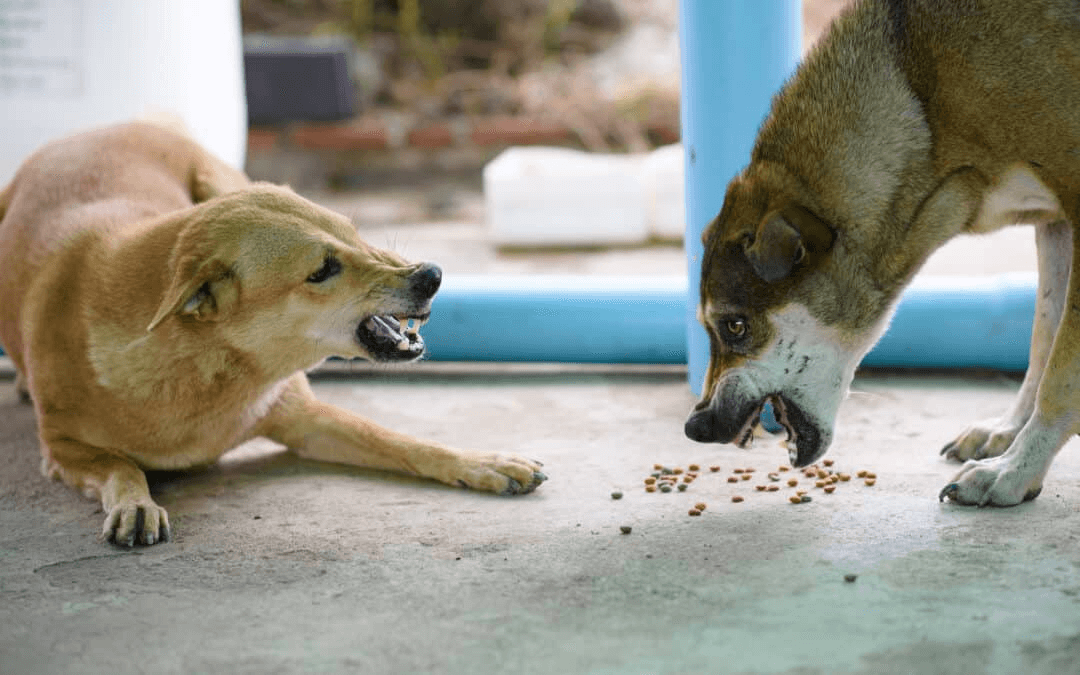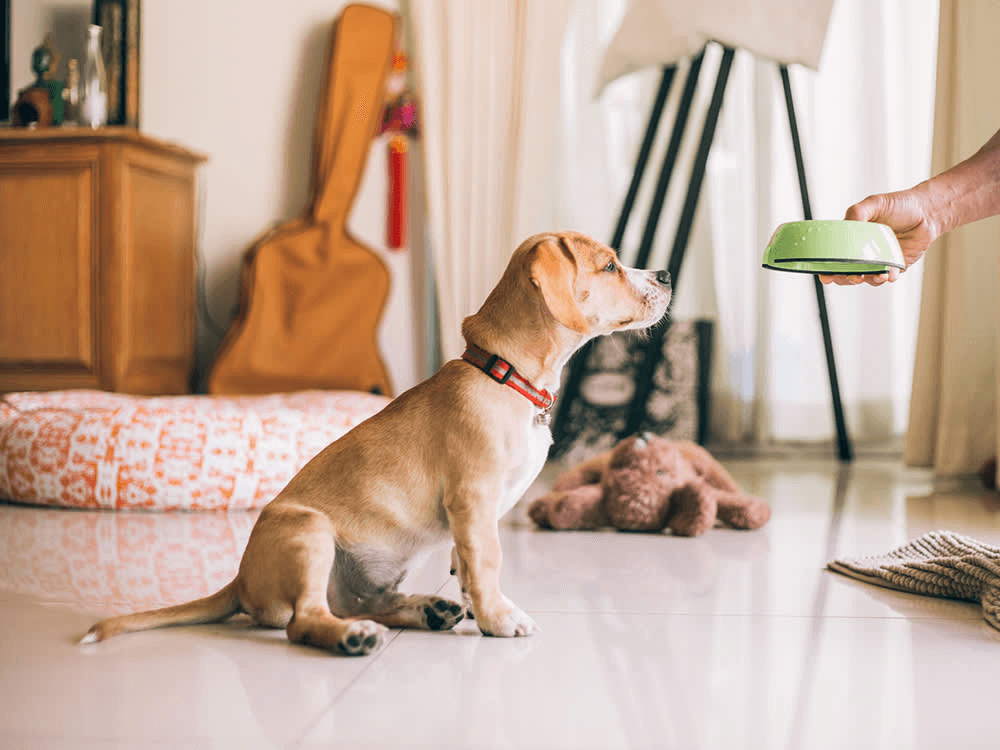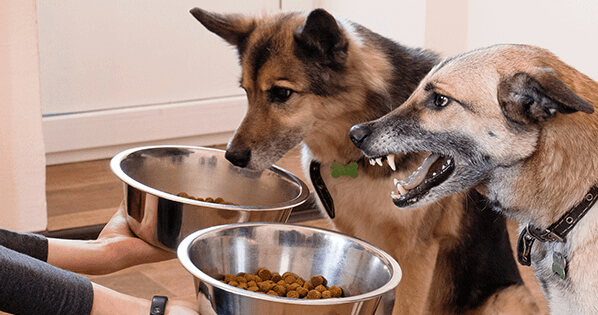To stop food aggression in dogs, you have to find the root causes and prepare a training course to help them improve positive behavior during the meal. Follow 8 tips to help pet owners create a harmonious feeding environment for their furry companions.
What Causes Food Aggression In Dogs?

While every dog is unique, several common reasons contribute to food aggression.
- Natural instinct to guard resources: Dogs has an innate drive to protect their food, rooted in their evolutionary history. This instinct can become heightened if they feel a sense of competition or scarcity around their meals.
- Past experiences: Dogs that have experienced limited access to dog’s food or have had to fight for their meals in the past may develop a heightened sense of possessiveness and aggression when it comes to their food.
- Anxiety and fear: Dogs with underlying anxiety issues or past traumatic experiences may feel heightened stress during mealtime, leading to defensive or aggressive behaviors around their food.
- Lack of proper socialization during mealtime: Dogs that haven’t been exposed to positive experiences and training around food may develop a sense of possessiveness when it comes to their meals.
- Medical issues: Pain or discomfort while eating can trigger defensive behaviors in dogs, leading to aggression towards anyone approaching their food.
8 Tips To Stop Food Aggression In Dog
To stop food aggression in dogs, first, you need to establish a consistent feeding routine and training with positive steps to create a happy feeding experience and discourage possessive behaviors.
Moreover, these have to combined with other tips to complete the training course. Here are all 8 useful tips to help your dog stop food aggression:
1. Establish a consistent feeding routine
Give regular mealtimes to establish a structured routine. Dogs thrive on predictability, and a consistent schedule helps them feel secure and reduces anxiety around food.

2. Use positive reinforcement training
Reward your dog’s calm and relaxed behavior during feeding. Use treat, praise, and gentle petting to reinforce positive associations with meal time, promoting a relaxed and non-aggressive attitude.
3. Hand-feeding and treats
Hand-feeding can help build trust and strengthen the bond between you and your dog. Offer treat and food from your hand to teach your dog that your presence during the time dog is eating is positive and non-threatening.
4. Avoid resource guarding triggers
Identify and avoid triggers that may contribute to resource food guarding. For example, if your dog becomes possessive over certain food bowls or areas, use another types of bowls or feed in a neutral location to minimize possessive behavior.
5. Create a calm feeding environment
Establish a quiet and calm environment like eating in a cozy home space. Minimize distractions, such as loud noises or other pets, that may cause stress or competition for food.
6. Feed dogs separately
If you take care of many dogs, feed them in separate areas at home to prevent food competition and reduce the likelihood of food aggression. Create for each dog their own designated feeding space to enjoy their meal in peace.
7. Utilize food puzzle toys
Engage your dog’s mind and encourage slower eating by providing food puzzle toys. These toys both stimulate their problem-solving skills and divert their focus from possessive behaviors.
8. Seek professional guidance if needed
If your dog’s food aggression persists or escalates despite your efforts, consult with a professional dog trainer or behaviorist. They can assess the situation, provide tailored guidance, and develop a behavior modification plan to address the underlying causes of food aggression.
What Are The Common Signs Of Food Aggression In Dogs?
Please pay attention to 7 common signs of aggression in dogs below to prevent and addressing:
Vocalization and growling
Dog exhibiting food aggression may growl, bark, or vocalize when approached while eating or if someone tries to take away their food. This vocalization serves as a warning signal for them to say “Don’t touch my food” and assert their possession over the dog’s food.

Stiff body posture
Dog displaying food aggression often exhibit a stiff body posture. Their muscles appear tense, and they may hold their body rigidly, leaning forward protectively over their food. This posture is a clear indication that they perceive a threat and are ready to defend their meal.
Protective stance
Dogs with food aggression may assume a protective stance, positioning themselves in a way that hovers over their food bowl. They may arch their body, lower their head, and use their body language to physically guard their food from anyone attempting to approach.
Snapping or biting
Dog’s food aggression may escalate their defensive behavior by snapping or biting at people or other animals who come too close to their food bowl. This aggressive response is an attempt to protect their valuable resource and assert dominance over it.
Freezing or staring
Dogs exhibiting food aggression may freeze in place or maintain intense eye contact when someone approaches their food bowl. This behavior is a warning signal, indicating that they are ready to defend their food if necessary.
Gulping food
Some food-aggressive dogs tend to eat quickly and gulp dog food down. This behavior stems from their instinct to secure their meal promptly, minimizing the chances of it being taken away by others.
Resource guarding
Food aggression is often accompanied by resource guarding, where dogs display possessive behaviors not only towards their food but also towards other valuable resources like treats or toys. They may growl, snarl, or exhibit aggression when someone attempts to take away these items.
Conclusion
By employing practical solutions and implementing the recommended techniques, pet owners can effectively address and stop food aggression in dogs.
Don’t forget, understanding the underlying causes and consistently applying the appropriate strategies will help create a safe and harmonious feeding experience for both the dogs and their owners.
FAQs
